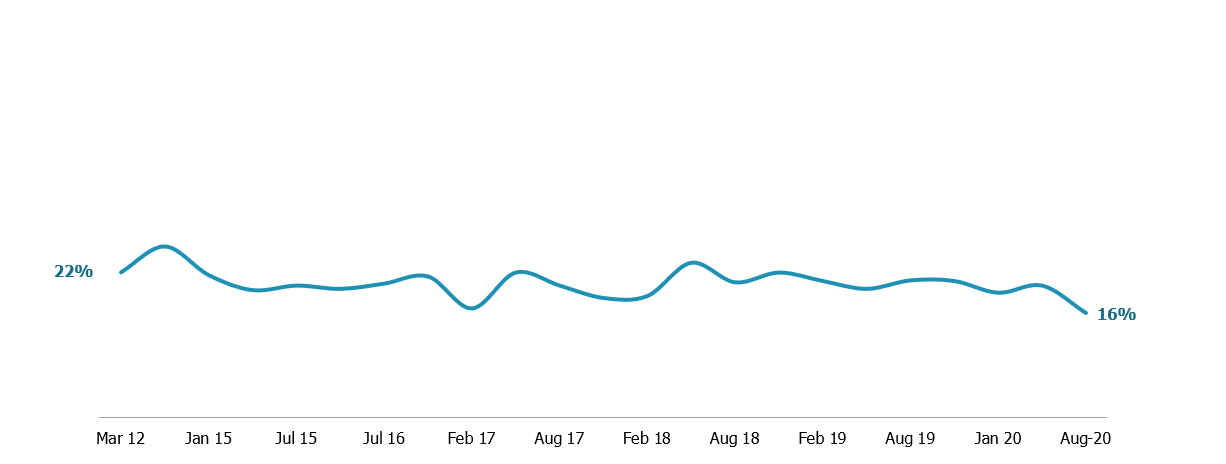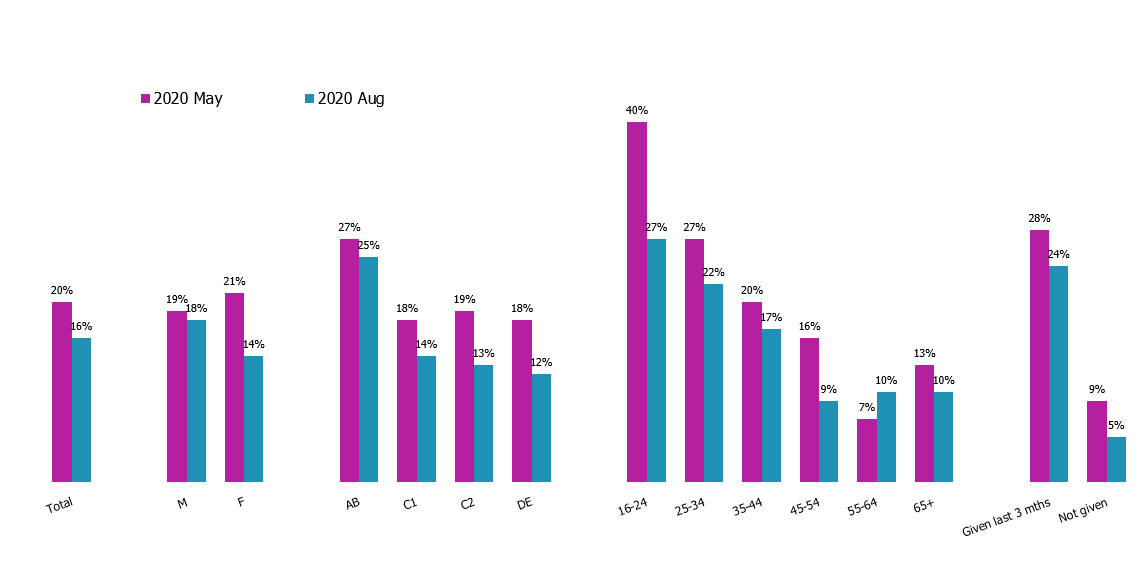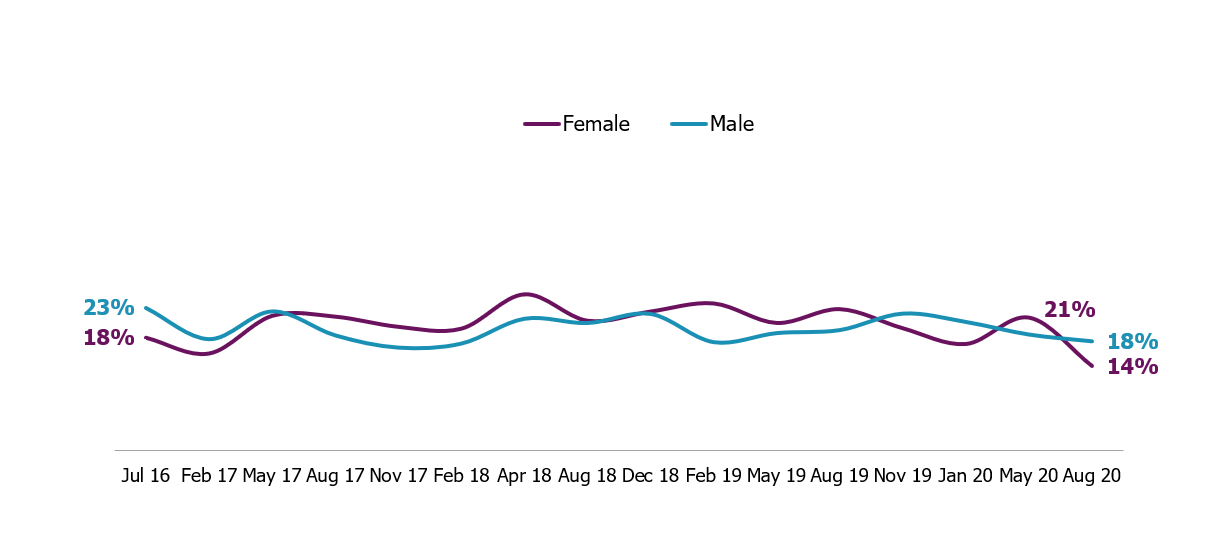The pandemic has proved somewhat of a paradox when it comes to volunteering. It has both limited the scope of opportunities through the government mandated social distancing regulations, but also increased incentives for public engagement through mutual aid schemes and responses to the struggling health care service back in April. The following blog explores six trends that have defined volunteering during the pandemic and offers some potential explanations for each.
Trend One - Volunteering levels have dropped to lowest in a decade
Volunteering rates have been relatively steady for over a decade now. Generally, we have observed in our tracking around a fifth of the population saying they have given time as a volunteer over a certain three-month period. This trend continued into the beginning of the pandemic, with 20% in May saying they had volunteered over the previous three months. In August this year however, we saw rates drop significantly to 16%. This is the lowest level of volunteering we’ve recorded since 2010. Despite all the rhetoric of a ‘volunteer army’ being touted at the beginning of lockdown, this has seemingly failed to translate into a significant increase in volunteering numbers and, in fact, we can observe numbers decreasing in Summer.
So, why is this? The first potential explanation is that whilst Covid has sparked an environment of civic duty and mutual aid, many have been engaged in informal actions such as collecting shopping for neighbours. This might not necessarily mean they would classify themselves as a ‘volunteer’, which is more traditionally associated with giving time to a formal cause or organisation. Secondly, volunteering opportunities have generally decreased due to concerns over health and safety and the inability for initiatives to go ahead under social distancing regulations. Although the outpouring of volunteers for the NHS made all the headlines towards the beginning of lockdown, a number of charity shops, festivals and community projects have all had to shut their doors to potential volunteers.
Chart A - Volunteer rates since 2012

"Have you given time as a volunteer in the last three months, to a charity or other organisation, or in your local community?”
Source: Charity Awareness Monitor, Aug 20, nfpSynergy | Base: 1,000 adults 16+, Britain
Trend Two - Volunteering rates amongst the older age groups have been suppressed by the pandemic
Unsurprisingly the pandemic has put a halt to a lot of volunteering amongst the older age groups. The increased vulnerability of the elder population and the need to shield for many has meant that volunteering amongst the 65+ age group dropped from around 25% before the pandemic to 13% in May and 10% in August. Similarly, volunteering rates amongst the 45-54 and 55-64 ages groups has seen significant declines.
With the first vaccines being rolled out in the UK this week and the promise that the elderly and most vulnerable will be the first to receive that vaccine, there are promising signs on the horizon of a return to pre-pandemic volunteering rates. We should however be cautious about predicting this return with too much certainty as mass immunisation is a long way off and the next year will surely be as much about public confidence as it will be about the presence of a vaccine. Volunteering amongst the elderly will depend on whether they feel safe enough to be out in public, and in the current climate, a fair degree of public scepticism towards the vaccine means that having the vaccine is one thing but buying into its efficacy and legitimacy is another.
Chart B - Volunteering rates during the pandemic

“Have you given time as a volunteer in the last three months, to a charity or other organisation, or in your local community?”
Source: Charity Awareness Monitor, Aug 20, nfpSynergy | Base: 1,000 adults 16+, Britain
Trend Three - Volunteering amongst the 16-24 age group spiked initially and then returned to pre-pandemic levels
Volunteering amongst the younger age groups saw a significant spike at the beginning of the pandemic with 40% of 16-24-year olds saying they had volunteered. This was a marked increase on previous years – 24% said they had volunteered in 2012 and 30% in 2018. There has also been an increase amongst 25-34 years olds compared to 2012 (19% vs 27%). This demonstrates the increasing emergence of this age group as a key volunteer group. However, the change compared to 2018 has not been overly significant, meaning the pandemic has not had such a notable impact on this group.
This spike may likely be attributed to the surge of volunteers responding to government calls for volunteers. With decreased vulnerability to Covid-19 it seems the younger demographic picked up the reduced footfall amongst the older age groups, meaning, overall, volunteer rates remained consistent during the first few months of the pandemic. As the pandemic ‘stabilised’ and concerns about the health service being overrun began to decline it would seem that the necessity of a ‘volunteer army’ reduced, hence volunteer rates amongst those age groups returned to their pre-pandemic levels. This return to ‘normality’ amongst the younger age groups, combined with the older age groups still being unable to re-engage with their usual commitments, might go some way to explain the overall drop from 20% - 16% between May and August.
Trend Four - Volunteering levels amongst women has declined
Female volunteering has remained relatively stable since we began tracking. Generally, it has hovered around 1 in 5 saying they have volunteered in the previous three months. The pandemic initially seemed to corroborate this trend with 21% of women saying they had volunteered in May. However, in August this year that number fell to 14% with significant reductions across almost all age groups.
Reaching a conclusion as to why this might be is of course tricky as there is likely a myriad of contributing factors. One potential explanation is perhaps that over summer with schools, nurseries and childcare services suspended the burden of childcare fell disproportionately on mothers, reducing their capacity to engage in volunteering activities. Given that the 55+ female age group remained stable at 11% during the pandemic and the falls from May to August were mainly within the 16-35 and 35-54 age groups, motherhood may well have something to do with this trend. Perhaps this is a slightly cliched explanation, but sadly might not be that far from the truth.
Chart C - Volunteer rates by gender

“Have you given time as a volunteer in the last three months, to a charity or other organisation, or in your local community?”
Source: Charity Awareness Monitor, Aug 20, nfpSynergy | Base: 1,000 adults 16+, Britain
Trend Five - Volunteering levels amongst men has remained stable
Volunteering amongst men has been relatively equal to women since we began tracking with around 1 in 5 men saying they had volunteered over a given three-month period. The pandemic has left this long-term trend relatively unaffected. 19% of men said they had volunteered at the beginning of the pandemic and 18% said the same in August. Of course, there are variations across age groups, with this number falling disproportionately on the younger generations.
Again, drawing generalised conclusions for gender demographics is difficult. The drop in volunteering amongst the older male population throughout the pandemic is likely to be the result of concerns over health and the need to shield. The stability in rates across the other male age groups is perhaps explainable by inverting the logic applied to women – chiefly that men were disproportionately unencumbered by the childcare duties that resurfaced over summer.
Trend Six - Volunteering levels amongst donors has remained stable
Volunteering amongst charity donors has also remained relatively stable throughout the pandemic with approximately 25% of volunteers also saying they were charity donors. These are the same rates that have existed across the last decade with 25% in 2012 and 27% in 2018 of volunteers saying they were charity donors.
The positive take away from this appears to be that the relationship between volunteering and donating has remained unaltered and the commitments made by the public to their favourite causes has not been significantly damaged. Of course, this data can’t tell us the amount of time spent volunteering or the size and regularity of their charity donation, which might plausibly have fallen during the pandemic. It does however offer a positive sign that the pandemic has not impeded those able to both volunteer and financially donate.

